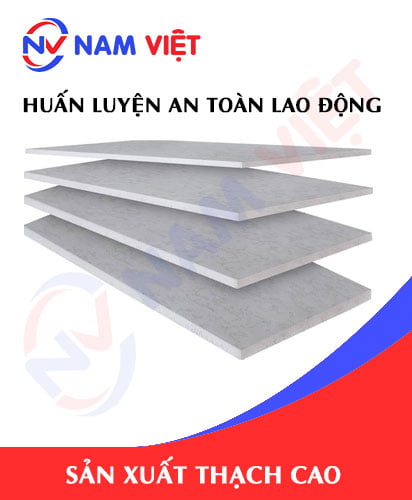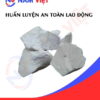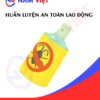Occupational safety training for gypsum production
99,000 ₫
Note: The above price is calculated per person, the price may fluctuate depending on the number of learners participating in the course and the market movement, for more accurate price support please refer to the pricing table or contact our consultants directly.
Occupational safety is an important issue in factories production gypsum and needs to be addressed promptly to ensure the health and safety of workers, enhancing the reputation of businesses. The Safety training course is one of the effective solutions to raise awareness about how to prevent occupational accidents for workers involved in production gypsum.
Table of Contents
Toggle1. Overview of Gypsum
a. What is Gypsum?
- Gypsum is a common building material made from hydrated calcium sulfate (CaSO4·2H2O). It is used to create false walls, ceilings, partitions, soundproof walls, etc.
- Gypsum has many advantages, including good fire resistance, flexibility in design and installation, high durability, and noise reduction capability. It is also easy to cut, drill, sand, and paint to suit specific design requirements.
- There are two main types of gypsum: regular gypsum and moisture-resistant gypsum. Regular gypsum is used in dry areas not exposed to water, while moisture-resistant gypsum is used in areas with higher humidity, such as bathrooms or kitchens.
- According to statistics from the Vietnam Construction Association, gypsum production in 2020 was estimated at about 15 million m2, an increase of 7% compared to the previous year. Gypsum manufacturing companies in Vietnam are growing and providing gypsum products with increasingly high quality and affordable prices, meeting the needs of the domestic and international markets.

b. Types of Gypsum Production Machinery
The types of machinery involved in gypsum production include:
- Crusher: Used to crush gypsum raw materials before feeding them into the kiln.
- Dryer: Used to dry gypsum particles after they have been ground.
- Mixer: Used to mix the gypsum compound with additives such as fiberglass, cellulose fibers, shaping agents, etc.
- Press: Used to press and shape the mixture of gypsum and additives into gypsum boards.
- Cutter: Used to cut gypsum boards into desired sizes and shapes.
- Grinder: Used to grind and pulverize cut gypsum boards into gypsum powder.
- Drill and Sander: Used to drill holes and sand gypsum surfaces for use in construction projects.
- Stacker: Used to stack gypsum boards into bags and cartons for transportation to a destination.
These machines are often used in gypsum factories to increase productivity and reduce production costs.

c. Gypsum Production Companies in Vietnam
In Vietnam, there are many gypsum production companies, including large enterprises such as:
- Knauf Group: Founded in 1932 in Germany, Knauf is one of the world’s largest gypsum producers. In Vietnam, Knauf established a gypsum factory in Phuc Dien Industrial Park, Long Bien, Hanoi in 2010.
- Saint-Gobain Group: A French multinational corporation, Saint-Gobain specializes in producing building materials, including gypsum. In Vietnam, Saint-Gobain also has a presence and manufactures gypsum at factories in Binh Duong and Hai Phong.
- Boral Group: A leading Australian building materials manufacturer, Boral also has gypsum production operations in Vietnam through its joint venture company, Boral Gypsum Vietnam.
- Bac Kan Gypsum Joint Stock Company: One of the largest gypsum production companies in Vietnam, headquartered in Bac Kan province. The company produces gypsum products of various types and sizes, serving domestic construction projects.
In addition, there are many smaller gypsum production companies in Vietnam, but they still make an important contribution to the domestic gypsum industry.

d. Specific Jobs in a Gypsum Production Factory
Group 1
- Executive director, deputy executive director, department head in a gypsum production factory.
Group 2
- Safety officer: manages safety in the factory, designs safety procedures, and supervises and urges employees to comply with safe work procedures.
Group 3
- Raw material extraction and transportation: This is the first stage in the gypsum production process. The factory must extract and transport raw materials such as limestone and gypsum from mining quarries.
- Crushing and grinding raw materials: Raw materials are crushed and ground into small particles to prepare for the next stage.
- Mixing: The raw materials are mixed together to form the gypsum compound.
- Pressing and shaping: The gypsum compound is pressed and shaped into gypsum boards.
- Drying: The gypsum boards, after being pressed and shaped, will be dried.
- Cutting and processing: The gypsum boards will be cut and processed into products of different sizes and shapes.
- Packaging and transportation: The gypsum products are packaged and transported to sales points or construction sites.
- Maintenance and repair: Maintenance and repair personnel maintain and repair equipment and machinery in the factory to ensure stable and efficient operation.
Group 4
- Office jobs, serving, sales, marketing.
- Production management, quality management, human resource management, material management, financial accounting management.
- Research and development of new products, designing product packaging designs.
2. Overview of the Gypsum Production Labor Safety Training Course
Within the scope of this article, we focus on issues related to Group 3, because Group 3 is the group directly involved in the production process and is at the highest risk for labor accidents. Refer to other groups here
a. What is Group 3 Labor Safety Training?
- Labor safety training for group 3 consists of sessions that provide awareness on how to prevent labor accidents for workers.
- The labor safety training course will help workers identify and avoid dangers, and limit the risks of labor accidents while working.
REGISTER FOR LABOR SAFETY TRAINING SERVICE
b. Training Duration
Initial safety training duration
- The total training duration is at least 24 hours, including the test time.
- 8 hours of theoretical study on the system of policies and laws on labor safety and hygiene.
- 8 hours of theoretical study on basic knowledge of labor safety and hygiene.
- 4 hours of theoretical study on specialized training content.
- 2 hours of practical training on specialized training content.
- 2 hours of theoretical testing at the end of the training course.
The safety training center will distribute the time into several training sessions depending on the time arrangement for employees. But usually, there will be 6 training sessions, the course will take place over 3 days, provided that the manufacturing company can arrange continuous study time.
Periodic safety training duration
- Before the labor safety card expires, if workers want to have it reissued, they must undergo a periodic labor safety training course, with a periodic safety training duration of at least 50% of the initial safety training duration.
Explanation: The total periodic labor safety training duration is at least 12 hours, including the test time. After completing the periodic training course and passing the test, the worker will be re-issued or have their labor safety card renewed.
c. Content of the training course
| No. | TRAINING CONTENT | TRAINING DURATION (HOURS) | |||
| Total | Of which | ||||
| Theory | Practice | Test | |||
| I | System of policies and laws on labor safety and hygiene | 8 | 8 | 0 | 0 |
| 1 | Overview of the system of legal normative documents on labor safety and hygiene. | 6 | 6 | ||
| 2 | System of technical standards and regulations on labor safety and hygiene. | 1 | 1 | ||
| 3 | Specific regulations of state management agencies on labor safety and hygiene when building new, expanding or renovating works, facilities for manufacturing, using, preserving, storing and inspecting types of machines, equipment, materials, and substances with strict requirements on labor safety and hygiene. | 1 | 1 | ||
| II | Basic knowledge of labor safety and hygiene | 8 | 8 | 0 | 0 |
| 1 | Basic knowledge of dangerous and harmful factors at the workplace. | 4 | 4 | ||
| 2 | Methods of improving working conditions. | 1 | 1 | ||
| 3 | Safety culture in production and business. | 1 | 1 | ||
| 4 | Rights and obligations of employers, employees; policies and regimes on labor safety and hygiene for employees; functions and duties of the labor safety and hygiene network. | 1 | 1 | ||
| 5 | Labor safety and hygiene regulations, safety signs, safety instructions and the use of safety equipment, personal protective equipment; first aid skills for labor accidents, and prevention of occupational diseases. | 1 | 1 | ||
| III | Specialized training content | 6 | 4 | 2 | 0 |
| General knowledge about types of machines, equipment, and substances that generate dangerous and harmful factors; analysis, assessment, and management of risks to labor safety and hygiene, safe working procedures with machines, equipment, and substances with strict requirements on labor safety and hygiene. | 6 | 4 | 2 | ||
| IV | Labor safety training test at the end of the training course | 2 | 2 | 0 | 0 |
| Total | 24 | 22 | 2 | ||
See more training content for 6 groups
d. Labor Safety Card
After completing the labor safety training course and passing the test, the worker will be issued a labor safety card (in practice, it is often called a Group 3 labor safety certificate).
The group 3 safety card will clearly state information such as: full name, date of birth, specific job and working environment. It also includes the training time, red stamp, and signature confirming the completion of the training course.
According to the regulations on issuing safety cards specified in Clause 2 of Article 24 of Decree 44/2016/ND-CP, there are two cases:
- Case where the employer and the employee have a labor contract with each other, the employer must sign, stamp, and seal the safety card for the trained person in Group 3 after they have gone through the training course from a labor safety training unit and passed the test.
- Case where the worker is a freelancer, seasonal worker, and does not have a labor contract, the training unit must sign, stamp, and seal the safety card for the worker after they have gone through the training course from a labor safety training unit and passed the test.

3. Identifying Dangers Affecting Workers in Gypsum Production
The production of gypsum can pose many dangers that affect the health of workers. Below are some common dangers and how to identify them:
- When producing gypsum, gypsum boards are often ground or cut, resulting in the creation of gypsum dust. This dust can cause respiratory problems such as bronchitis, asthma, or lung cancer. How to identify: Gypsum dust is often white, light, and floats in the air. Workers can recognize gypsum dust by seeing or inhaling it.
- Machinery in a gypsum factory creates loud noise, causing hearing problems such as hearing loss or hearing damage. How to identify: Noise is often at a high level and can be heard clearly from a distance.
- During the gypsum production process, toxic gases such as SO2, CO2, NOx, CO, H2S… can be generated. These toxic gases can cause health problems such as headaches, nausea, or cardiovascular disease. How to identify: Toxic gases are often odorless or have an unpleasant odor and workers may feel uncomfortable, nauseous, or dizzy.
- Equipment in a gypsum factory can generate high voltage, posing a danger to workers. How to identify: High voltage is often displayed on the equipment, and workers may feel a tingling or shock when in contact with high voltage.
4. Types of Labor Accidents that Often Occur to Workers in Gypsum Production
The types of labor accidents that often occur to workers in gypsum production can include:
- Accidents due to machinery: Machinery in a gypsum factory can cause labor accidents such as crushing, cutting, collision, or being caught. These accidents can cause serious injury or death to workers.
- Accidents due to materials: When producing gypsum, gypsum boards can fall and cause injury to workers.
- Electrical accidents: Equipment in a gypsum factory can generate high voltage and cause labor accidents such as electric shock.
- Accidents due to liquids: When producing gypsum, liquids such as acids or other chemicals can cause labor accidents such as burns or spills.
- Accidents due to dust: When producing gypsum, gypsum dust can cause labor accidents such as respiratory inflammation or lung cancer.

5. Safety Measures When Participating in Gypsum Production
To ensure the safety of workers involved in gypsum production, the factory needs to implement the following safety measures:
- Ensure protective equipment: Workers must be provided with full protective equipment such as helmets, safety glasses, gloves, masks, safety shoes, protective gowns, etc.
- Comply with work procedures: Workers must be trained to understand the work procedures, from handling raw materials to producing the final product, to avoid accidents due to lack of information.
- Regularly inspect and maintain equipment: Equipment must be regularly inspected and maintained to ensure good operation and minimize risks.
- Operate equipment correctly: Equipment operators must be trained and experienced to ensure correct operation.
- Maintain cleanliness: The factory must maintain cleanliness to reduce risks.
- Use safe cleaning agents: Workers must be instructed on how to use safe cleaning agents to reduce the risk of burns.
- Train workers on labor safety: Training must be provided to workers to help them understand the risks and safety measures during the production process.
- Periodically organize work environment monitoring in factories and enterprises, collect and analyze harmful factors for workers, thereby adjusting to reduce the level of harm to prevent occupational diseases for them.
6. Benefits of Labor Safety Training for Gypsum Production
An Toan Nam Viet provides your business with great benefits after completing labor safety training courses as regulated in Decree 44/2016/ND – CP on labor safety and hygiene, for companies, factories, and enterprises.
- Workers can recognize the potential risks of labor accidents and from there, have preventive measures to avoid labor accidents.
- Your business can establish risk prevention measures in the production, operation and maintenance processes.
- Minimize costs when unsafe situations occur in labor.
- Uninterrupted production processes will help increase labor productivity and product quality.
- Comply with labor safety laws, avoiding legal risks.
- Create a reputation and professionalism in all aspects, thereby enhancing the brand for your business.
Nam Viet’s training courses are the solution to prevent and combat external factors that affect each individual so that they can avoid danger that can lead to injury or more seriously, death.
REGISTER FOR LABOR SAFETY TRAINING SERVICE
7. Customer Feedback after Completing the Gypsum Production Labor Safety Training Course
An Toan Nam Viet has many years of experience in the mission of accompanying many businesses in Vietnam in general and in the southern provinces in particular. And that responsibility is something extremely precious to Nam Viet, which is why Nam Viet’s Labor Safety Training work is always focused on being more and more professional. And the motivation for An Toan Nam Viet to grow strong to the present comes from the positive feedback and suggestions from the businesses. Below are the responses from our partners whom we have served.
Bac Nam E&C Investment and Construction Joint Stock Company
“The first time I used the service at An Toan Nam Viet I was very surprised by the enthusiastic 24/7 support of the consulting team. The class organization was very fast and convenient for our company, thank you very much for Nam Viet’s service!”
Hoa Dat Construction and Trading Joint Stock Company
“Nam Viet’s service has helped us a lot in simplifying labor safety and the process of completing safety records for our work. The consulting team is enthusiastic and timely in answering our questions. 5 stars for Nam Viet”
See more customer interviews after using An Toan Nam Viet’s service
8. An Toan Nam Viet’s Labor Safety Training Capacity
An Toan Nam Viet is a reputable and quality labor safety training center in Vietnam today. With labor safety training sessions taking place continuously at production workshops, factories or construction sites across the country (63 provinces in Vietnam).
REGISTER FOR LABOR SAFETY TRAINING SERVICE
Labor safety training license
- An Toan Nam Viet has been inspected and licensed by the Department of Labor Safety of the Ministry of Labor – Invalids and Social Affairs, which issued a certificate of eligibility to operate in labor safety and hygiene training. This further strengthens our capacity for labor safety training.

Documents and lectures
- Before the labor safety training documents are put into the labor safety training courses, they have been reviewed and approved to ensure that the lectures are accurate in knowledge and effective when applied.
- The teaching method of the lecturers is synchronized according to the teaching standards of An Toan Nam Viet, which is a method that experts in labor safety and hygiene training have researched and concluded during the teaching process to bring the highest knowledge absorption efficiency to students.
Facilities
- Controlling the factors in the classroom that affect the training process will increase the teaching performance and the knowledge absorption efficiency of students.
- Our facilities to support the training course always arrange spacious classrooms that meet the standards of area, lighting, training equipment, etc.
9. Reputable and quality national safety training center
At An Toan Nam Viet, we always put our professional dedication to labor safety training first. For us, imparting the knowledge of self-protection to workers so that they can have a safe luggage on their path of livelihood is a contribution to building the country.
To ensure effective training, we prepare carefully and meticulously every little detail, even the smallest. From preparing tools, equipment, teaching aids to textbooks, documents, sound, and lighting.
Our labor safety training lecturers are experts with many years of experience in the field. They even have research projects identifying the hazards in all occupations and how to prevent them.
The lecturers’ lessons are summarized from practice and conveyed in the most vivid and easy-to-visualize way to workers. Those factors help workers feel comfortable during their study time and absorb our teaching knowledge well. Of course, the knowledge conveyed always closely follows Decree 44/2016/ND-CP.
From there, they grasp many measures to prevent danger and how to protect themselves. At the same time, they also apply it in the most appropriate way in their actual work.
Our safety training center is proud to be a reputable and professional provider of labor safety training services with the following advantages:
- Competitive training costs but guaranteed training quality.
- Flexible training schedule to match the production situation of the company.
- Fast and legally compliant procedures for issuing labor safety training certificates.
- The training lecturers are people with many years of experience in the profession.
- The classroom is controlled for factors affecting the training process, which increases the teaching performance and knowledge absorption efficiency of students.
- The lectures are compiled to be suitable for labor safety work at businesses.
- An Toan Nam Viet works with dedication and professionalism to support customers accurately and as quickly as possible.

10. Refer to more Gypsum Production Labor Safety Training Documents
- Gypsum production labor safety documents
- Set of labor safety training documents
- Set of labor safety training test questions
- Gypsum production labor safety multiple-choice test
- Slides for gypsum production labor safety training lectures
1 review for Occupational safety training for gypsum production
No comments yet















namchinh.haiphong341
Dịch vụ huấn luyện an toàn lao động rất tốt nhé, giảng viên dạy rất sinh động dễ hiểu!